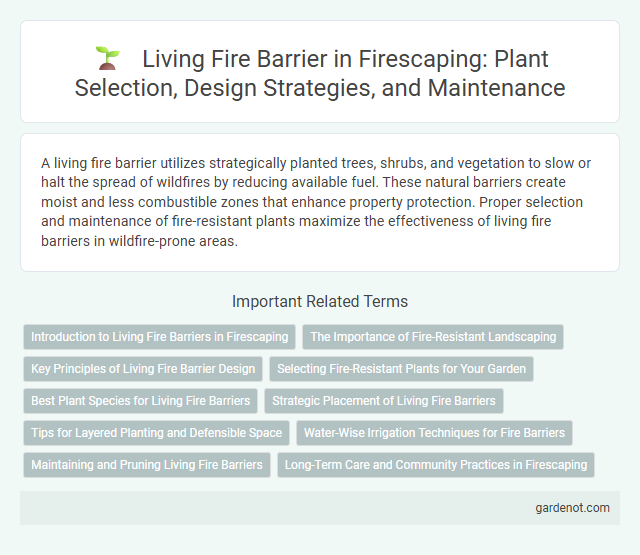A living fire barrier utilizes strategically planted trees, shrubs, and vegetation to slow or halt the spread of wildfires by reducing available fuel. These natural barriers create moist and less combustible zones that enhance property protection. Proper selection and maintenance of fire-resistant plants maximize the effectiveness of living fire barriers in wildfire-prone areas.
Introduction to Living Fire Barriers in Firescaping
Living fire barriers are strategically designed landscapes using fire-resistant plants to slow or stop the spread of wildfires near structures. These fire-adapted plants contain high moisture content and low resin levels, creating a natural buffer that reduces heat and flame intensity. Incorporating living fire barriers into firescaping plans enhances property protection by combining ecological sustainability with fire prevention.
The Importance of Fire-Resistant Landscaping
Fire-resistant landscaping plays a crucial role in creating living fire barriers that significantly reduce wildfire risks around homes and properties. Incorporating drought-tolerant, fire-resistant plants such as succulents, lavender, and native species helps slow the spread of flames and minimizes combustible materials near structures. Strategic placement of gravel, stone, and well-maintained green spaces further enhances the effectiveness of living fire barriers by interrupting potential fire pathways.
Key Principles of Living Fire Barrier Design
Living fire barriers rely on selecting fire-resistant plant species and strategic placement to minimize fuel continuity and reduce wildfire spread. Key principles include maintaining moisture-rich vegetation, ensuring vertical and horizontal spacing between plants, and integrating hardscape elements for effective firebreaks. Proper maintenance such as regular pruning and removal of dead material enhances the barrier's fire-resistant properties.
Selecting Fire-Resistant Plants for Your Garden
Choosing fire-resistant plants such as lavender, succulents, and native grasses significantly reduces wildfire risk by creating a living fire barrier around your garden. These plants typically have high moisture content, low resin levels, and minimal leaf litter, which helps prevent rapid fire spread. Incorporating them strategically in fire-prone areas enhances garden resilience and supports sustainable firescaping practices.
Best Plant Species for Living Fire Barriers
The best plant species for living fire barriers include fire-resistant varieties like manzanita, ceanothus, and california lilac, which possess low oils and resins that reduce flammability. Succulents such as agave and aloe are also highly effective due to their high moisture content, creating natural fire breaks. Incorporating native drought-tolerant plants ensures resilience and enhances the fire-resistant properties of living fire barriers.
Strategic Placement of Living Fire Barriers
Strategic placement of living fire barriers involves positioning fire-resistant plants, such as succulents and fire-retardant shrubs, in zones most vulnerable to wildfire exposure, including property perimeters and areas near structures. These barriers reduce fire intensity by creating green buffers that retain moisture and slow down fire spread through dense, well-maintained vegetation. Prioritizing native species with high moisture content and low flammability ensures optimized protection and sustainability in fire-prone landscapes.
Tips for Layered Planting and Defensible Space
Layered planting creates multiple vegetation zones that slow fire spread and increase defensible space effectiveness. Use low-flammability plants with high moisture content near structures, gradually transitioning to taller, fire-resistant species farther away. Regularly maintain each layer by pruning, removing dead vegetation, and spacing plants to reduce fuel continuity.
Water-Wise Irrigation Techniques for Fire Barriers
Living fire barriers rely on water-wise irrigation techniques to maintain plant health while conserving water resources, essential in fire-prone landscapes. Drip irrigation systems deliver precise moisture directly to root zones, minimizing evaporation and reducing water waste. Integrating soil moisture sensors further optimizes watering schedules, ensuring plants remain resilient against wildfire threats without overwatering.
Maintaining and Pruning Living Fire Barriers
Maintaining living fire barriers involves regular pruning to remove dead or overgrown vegetation that could fuel wildfires. Proper pruning techniques enhance the barrier's effectiveness by promoting healthy growth and minimizing flammable materials near structures. Consistent maintenance ensures optimal fire resistance and supports the long-term functionality of the living fire barrier.
Long-Term Care and Community Practices in Firescaping
Living fire barriers enhance long-term care through sustainable plant selection that resists ignition and maintains moisture retention, reducing wildfire risk near communities. Community practices in firescaping involve collaborative maintenance, regular pruning, and native species integration to strengthen fire resilience and ensure ecological balance. Implementing living fire barriers fosters safer habitats while supporting local biodiversity and minimizing firefighting costs.
Living fire barrier Infographic

 gardenot.com
gardenot.com